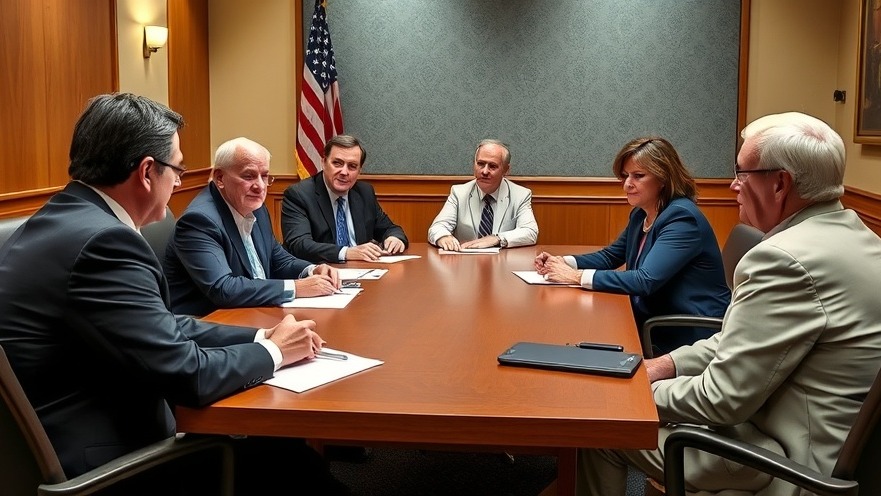
Texas Faces a New Reality in Flood Preparedness
In an alarming response to the recent catastrophic flooding that devastated Central Texas, Texas Lieutenant Governor Dan Patrick has announced the formation of a joint Disaster Preparedness and Flooding Committee composed of nine state senators. The initiative will commence with an initial meeting in Austin and followed by a session in Kerrville on July 31, allowing residents to voice their pressing concerns regarding flood recovery. This committee, a crucial part of Texas's legislative response, stands as a commitment to addressing not only the immediate aftermath but also the systemic issues that contribute to flood-related disasters.
A Legislative Push for Change
The joint committee, which includes both Republicans and Democrats, represents a collaborative effort to tackle the legislative shortcomings that became evident after this summer’s disaster. With over 120 confirmed fatalities and hundreds more reported missing, it highlights the urgent need for improved flood preparedness and emergency communication systems that Governor Greg Abbott and other state officials plan to prioritize in the upcoming special session slated for July 21.
“Right now, we must focus on the recovery of those still missing, then rebuilding communities in flooded areas,” stated Lt. Gov. Patrick, underscoring the immediate human toll of the flooding. This wave of increased attention on disaster preparedness comes at a pivotal time, especially as previous efforts during the regular legislative session fell short in securing comprehensive reforms.
Committee Composition: Who is Leading the Charge?
State Senators Charles Perry and Pete Flores will head the committee as chair and vice chair, respectively, supported by a diverse group of lawmakers that includes Senators Paul Bettencourt, Adam Hinojosa, and Democrats César Blanco and José Menéndez. This bipartisan group aims to develop strategies to prevent future disasters, showcasing an acknowledgment that this issue transcends party lines.
Historical Context: Understanding Central Texas Flooding
Central Texas has a long-standing history of flooding, exacerbated by its geographical layout and rapid population growth. Events like the July Fourth floods have revealed vulnerabilities in natural disaster preparedness and response. The Guadalupe River topping 36 feet in Kerr County serves as a tragic reminder of the area's susceptibility to flash floods.
Historically, floods in areas like Hunt, where devastation was particularly severe this month, have elicited criticism regarding the state’s flood management policies. As communities grapple with the loss and destruction, it becomes imperative to develop more effective policies to mitigate future risks.
What Residents Want to See from Legislators
The proposed meetings are set to provide an avenue for residents of Hill Country to communicate their experiences and express what they feel needs to be prioritized in the legislative agenda. Residents affected by flooding often seek assurances about improvements to infrastructure, better emergency services, and more transparent communication from state agencies in times of crisis.
Future Opportunities and Trends: Evolving Disaster Preparedness
As lawmakers gear up for this special session, it presents an opportunity to rethink Texas’s approach to disaster management. Experts are increasingly advocating for investment in technology and data-based systems that would enhance the state's emergency response framework. This could include developing advanced warning systems and more resilient infrastructure to withstand floods.
By looking to the future, Texas could set a precedent for other states facing similar challenges, making strides toward proactive rather than reactive disaster management strategy.
Why This Matters: The Impact on Local Communities
For community members in Texas, the effectiveness of this committee could mean the difference between recovery and recurrence after a disaster. Local voices must resonate within legislative halls to ensure that funds and resources are allocated effectively, rebuilding trust between constituents and their elected representatives.
Common Misconceptions About Flood Preparedness
Many believe that living in certain 'at-risk' areas automatically means floods are unavoidable. However, flood preparedness is about comprehensive emergency management, which includes infrastructure improvements, enhanced communication strategies, and community engagement. Education on these topics remains critical in changing mindsets and preparing residents to contribute actively to safety measures.
Given the high stakes, it is vital for Texans to engage in this discussion. Keeping abreast of legislative developments not only empowers individuals but also ensures safer communities capable of enduring the unpredictable nature of Texas weather.
As we approach the upcoming meetings, stakeholders, residents, and lawmakers alike are urged to participate actively in building a safer, more resilient Texas.
 Add Element
Add Element  Add Row
Add Row 



Write A Comment